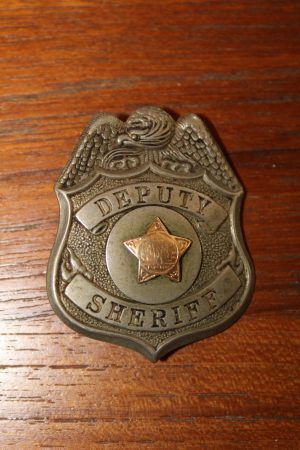
Patrick Gorham’s badge.
Pinal County’s not so distant past can be called “wild and wooly.” Gunfights, murders, stagecoach robberies, lynching and all the other typical happenings in Old West movies are in fact part of our county’s history. And for one Pinal County family, it’s a matter of family lore.
Patrick Aloysius Gorham was the son of Peter and Anna Gorham, Irish immigrants who settled in the United States around 1864. Patrick was born on January 28, 1875 in Ashley, Pennsylvania. After his father was killed in a coal mining accident, Patrick traveled to Leads, South Dakota where he visited one of his uncles around 1901. The October 28, 1904 issue of the Wilkes-Barre News reported that Patrick had spent the last two months visiting family in Ashley. It said Patrick Gorham “returned last evening to the West, where he holds a responsible position in a gold mine at that place” (Leads, South Dakota). “During Mr. Gorham’s stay in Ashley he told many interesting stories of the gold fields.”
In South Dakota, he became involved with an Italian girl who he ended up getting pregnant. He was forced to leave under pressure from her family. The woman was sent to California where she gave birth to a son. Many years later, the Gorham children were surprised to meet their brother that they never knew. Patrick headed for Arizona where he would settle in the Bisbee-Douglas area. He worked at a mine in Bisbee and while there met Joe Hardwick, a deputy who would later play an important part in an incident in Patrick’s life.
In 1910, he went to work at the new Territorial prison in Florence as a guard. Florence prison was built in 1908 to replace the old Yuma Territorial Prison. In August of 1914 Patrick was involved in the pursuit of an escaped convict with W.W. Stovall an engineer at the prison and W.T. Branaman from Florence. At Rillito they were in the process of searching the train for the escapee when a man armed with a Winchester rifle pointed his weapon at Branaman and threatened him for no apparent reason. After a few seconds when he saw others approaching, the man with the gun left quickly. The men reported the incident to Pima County authorities who caught up with the man who later was referred to as “the Russian.” A deputy shot him in the leg as he ran from them. The Russian ended up bleeding to death as an artery had been struck by the deputy’s bullet. Gorham and the men from Florence were called in to testify at the coroner’s hearing that the man who threatened Branaman was the same one the Pima County deputy shot and killed. It turned out that the Russian had threatened others around Rillito and had robbed a man. The shooting was ruled justified.
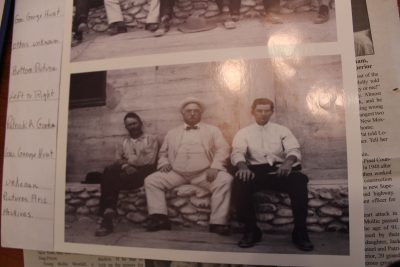
Patrick Gorham on left, Governor Hunt in middle, man on the right is unknown. Probably taken at the prison in Florence
While working at the prison, Patrick met Territorial and Arizona’s first state Governor, G.W. P. Hunt and they became friends. In June of 1915, Pat was selected by the Governor as one of the delegation to the christening of the U.S.S. Arizona battleship at the Brooklyn, New York Naval Yard. The trip was by train and Governor Hunt was accompanied by his Chief of Staff, Adjutant General, Charles W. Harris, and by Pat Gorham and H.R. Stevens, guards at the Arizona State Prison. Gorham and Stevens were Hunt’s bodyguards for the trip.
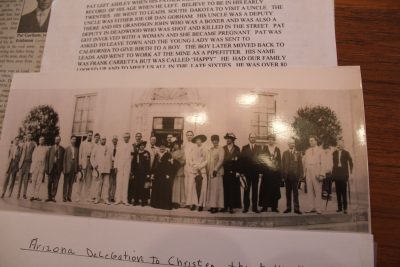
At the White House with President Woodrow Wilson; Patrick Gorham was part of the delegation for the christening of the USS Arizona.
The Arizona delegation first visited Washington D.C. where they were given a reception at the White House by President Woodrow Wilson. They posed for a photograph with him. In New York, the delegation was headquartered at the Waldorf-Astoria hotel. They spent several weeks back east visiting the sights of New York City. They met inventor Thomas Alva Edison and were treated to a luncheon on his estate. They also visited Sing Sing prison in New York.
On June 19, 1915, the battleship Arizona was christened. There was some controversy before the christening. Arizona was a “dry” state having passed a prohibition law which took effect on January 1, 1915. Instead of using a traditional bottle of champagne, the Arizona delegation had brought a bottle of the first water to flow over the new Roosevelt Dam. Some of the older naval personnel felt it would be bad luck not to use champagne for the launch. A compromise was made and two bottles were used, one of the Arizona water and one of champagne.
Later in 1915, Patrick was hired as a Deputy Sheriff by Pinal County Sheriff Henry Hall. In Florence, Pat met Mollie Westfall who was working at the post office. They were married in 1917.
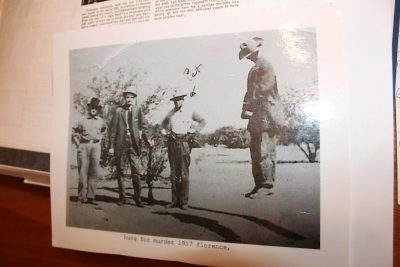
Pat Gorham at the lynching of Star Daley.
On May 6, 1917, Patrick was present at the site of the “lynching” of Star Daley. Patrick had been ordered to the scene to investigate and arrived after the hanging. Daley, whose real name was Vane Ashemore, had been arrested for the murder of James Ray Gibson and the kidnapping and rape of Gibson’s wife along the Apache Trail. The Richardsons were on their way to their home in Globe from Tucson when they stopped to camp somewhere between Superior and Mesa. It was there that Daley shot and killed James Richardson. He then, as the newspapers put it, “outraged” Mrs. Richardson during the night. He then stole the Richardson’s car and fled toward Mesa with Mrs. Richardson. When the car ran out of gas, he left Mrs. Richardson with the vehicle and began walking. He was arrested in Mesa.
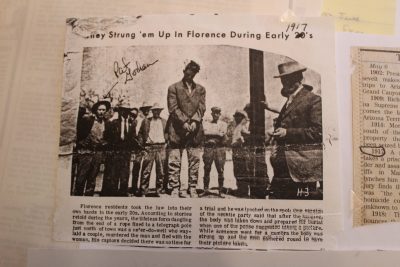
Pat Gorham at the lynching of Star Daley.
Daley was taken to the Maricopa County Jail in Phoenix. The Maricopa County Sheriff heard about a plot by vigilantes to remove Daley from the jail and lynch him. He felt it prudent to have Daley escorted to the state prison in Florence where he would be safe. Two officers took Daley in a car and headed for Florence. Fifteen minutes later the vigilantes found out and headed after the police officer’s vehicle. Friends in Pinal County were notified and the officers and Daley were stopped at a roadblock set up by the Gila River bridge a few miles from the prison. The vigilantes took Daley back near the scene of the crime and hanged him from a telephone pole. A hole was dug and he was buried on the spot. It was the last lynching in Arizona.
There is a story that after Daley’s body was taken down and being prepared for burial, that a group of people showed up and wanted to get their photo taken with Daley hanging from the pole. It may have been a newspaper photographer that wanted a photo. They were so insistent that Daley’s body was re-hung on the pole while more photographs were taken. There are some photos to back up the story, one taken of Daley with his hat on and one without.
Some newspaper editorials blamed the lack of the death penalty as the reason for the vigilante hanging. No one was ever prosecuted for the lynching. Politicians called for the reinstatement of the death penalty over the incident. After the Power shootout incident in 1918, with three law enforcement officers being killed, the cry for the death penalty ended with the law being changed.
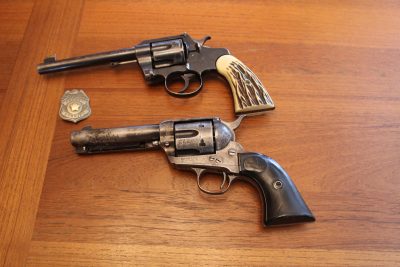
Pat’s gun including a .45 caliber Peacemaker
In September of 1918, it was reported in the newspaper that “District Attorney Richardson and deputies Henderson and Gorham made a liquor raid in Ray Thursday night that netted 80 gallons of wine and 21 quarts of whisky.” Soon after, Patrick was offered the job of chief deputy of Superior. The Gorhams moved there in November 1918. Magma Copper Company provided them with a house. They would raise 11 children, eight boys and three girls in Superior.
On the day they arrived in Superior, hundreds of people were in the streets shouting and firing off their guns. Mollie thought the town had come out to greet the new deputy’s arrival. It turned out it was November 11 and World War I had just ended. That date would become Armistice Day which is now more commonly known as Veteran’s Day.
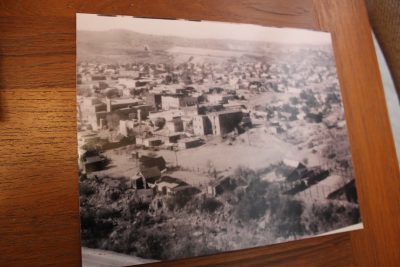
Gorham home in foreground
Superior was a rough mining town. There were many saloons and a brothel located in the center of town. One of the bars was known as “The Bucket of Blood” as just about every week there were fights in the saloon with someone shedding their blood on the floor as the result of fisticuffs, a knife fight or a shooting. Like other mining towns in the early days, the mining companies controlled what went on in their company owned town. Magma Copper had their own police force who were deputized by the Pinal County Sheriff. On Christmas Eve 1917, near the Magma Club where a dance had been in progress, two of the police force got into an argument that turned into a gunfight resulting in the death of the night watchman and the other officer being arrested.
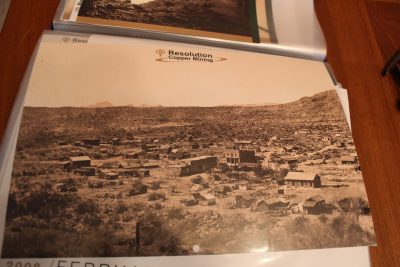
Superior around 1920
In March of 1920, Gorham’s young law enforcement career nearly came to an end. The Bisbee Daily Review reported: “A shot from the revolver of Deputy Sheriff Joe Hardwick killed Jose Sierra, a Spaniard, at Superior last Friday night just in time to save the life of Deputy Sheriff Patrick Gorham who was covered by the Spaniard’s gun.”
Gorham and Hardwick had been on their way to serve a warrant on Sierra. The warrant had been written on a complaint by Sierra’s cousin, who charged that Sierra had threatened to kill himself and his wife. As the officers were walking up the street, they were met by the woman running and screaming with Sierra chasing her with a gun in his hand. Sierra then pointed the gun at Gorham. The newspaper said: “When the Spaniard saw Gorham he said, ‘I know you, Gorham’ and covering him with the revolver was about to shoot when Hardwick’s prompt and accurate action with his gun put an end to his life.”
“Montana Joe” Hardwick, as he was known in Bisbee, was the Chief Deputy Sheriff at Ray. He would later become the Chief of Police for the border city of Calexico, California. During his law enforcement career, which included positions at Bisbee, Cochise County, Pinal County and Yuma, he was involved in a number of shooting scrapes, being wounded at least three times.
Gorham’s methods of law enforcement were unconventional by today’s standards. If Gorham accused you of a crime, you were guilty. If he wanted a troublemaker out of town, they left one way or the other. Superior was a town with a population of 3,000 when Gorham became the Deputy Sheriff. Much of the time, Gorham was on his own keeping the peace in Superior. He earned the respect of the townspeople. He rarely raised his voice in anger and was not known to flaunt his authority. There are stories told about him, that when he caught men fighting in the saloons, he would march them to the Magma Club, where there was a boxing ring. He would let them work out their problems in the ring. The loser went to jail for the night.
On paydays, he was allowed two deputies. Despite prohibition, it was an open town with speak easies, gambling and prostitution as a way of life. There were many single miners who traveled the “tramp mining circuit” from Bisbee to Butte, Montana. They traveled from mine to mine stopping in Superior to earn a grub stake before moving on to another mine. Magma mine was a difficult mine to work in. It was hot and dangerous. Having an open town for the miners to blow off steam, helped keep these experienced miners in town. When Gorham arrested a miner for drunkenness or a misdemeanor, he always made sure that miner was released in time to make it to work for his next shift.
At midnight April 13, 1924, the town of Superior was awakened by a tremendous roar of an explosion up near Apache Leap. Pat Gorham was one of the first responders to what became a bizarre murder mystery. Pat and a number of curious Superior residents arrived at the home of Frank Hutchison and his wife Nellie. Frank Hutchison, bleeding from the head, told Gorham that someone had murdered his wife. Gorham notified Sheriff Enis Thurman and the coroner who arrived from Florence within an hour.
Someone had killed Nellie by placing dynamite beneath the bed where Nellie and Frank slept. Frank said he had heard a noise and gone outside to investigate when the explosion happened. Thurman, after talking with Hutchison, ordered his deputies to search in the nearby hills and caves. Hutchison had reported seeing two Mexicans running from the scene shortly after the explosion.
According to the story from the Gorham family, Patrick and a posse found two Mexicans in a cave near Apache Leap. The posse wanted to immediately lynch the Mexicans but Patrick prevented them from doing it. It was a good thing, as Frank Hutchison confessed to murdering his wife 10 days later.
On Sept. 15, 1929, a Mexican named Cuadras stumbled into Gorham’s office around 11:30 at night and reported that he and four others had been searching for the Lost Dutchman gold mine when they were fired upon. He had run and hiked 12 miles to the highway where he was able to get a ride into Superior. A search party of officers and armed civilians was organized and began the search in the Superstition Mountains. They found everyone in the party of treasure hunters except for an unidentified Mexican. The treasure hunters were Cuadras, Mrs. Hope Gale, Joe Harrington, an unidentified Mexican and a Yaqui Indian guide named Jesus Sanchez. It was reported that the Yaqui guide had persuaded Mrs. Gale and Harrington to search for the lost mine after Sanchez told them he had known of the location for many years. Upon finding the group. It was learned that Mrs. Gale’s ex-husband Richard Gale had been known to have been following them and it was believed that he was the one who had shot at them.
The Arizona Republic reported: “Gale was found by Deputy Sheriffs Pat Gorham and Bill Robinette wandering about several miles from the scene of the reported shooting and was taken to Tex Barclay’s ranch, in the Weaver’s Needle district, before being brought here.”
During prohibition, organized crime had moved in to the larger cities of Arizona. In 1929, an organized gang in Phoenix thought they could move into Superior and take over the lucrative gambling and bootlegging business. The Phoenix mob sent in some of their men to begin setting up their operation. Gorham soon found out about the new men in town and their plans. Patrick and two deputies rounded up the city slickers and drove them to the summit of Gonzales Pass, which is located between Superior and Apache Junction on Highway 60. There, the deputies confiscated their shoes and tied the hands of the mobsters behind their backs. Gorham pointed the gang in the direction of Phoenix and told them to get to walking and never come back to Superior. They never did return.
On a hot summer day in 1933, an ex-cowman got drunk and began shooting up his neighborhood. The old man, Dan Neal at 6:00 in the morning took his Winchester rifle and began shooting at anything he saw. A young miner and his wife were sleeping out on their porch and were awakened by the noise of the gun shots and the bullets striking the porch. They began yelling at Neal as they ducked and dodged the gunfire. Neal apparently got bored and headed for Main Street. The street quickly emptied and calls went out for Gorham. Neal stood in the middle of the street with his gun at the ready, looking for an opportunity to shoot. One of Gorham’s deputies was hunkered down in the drugstore corner of the Magma Hotel trying to decide whether to rush Neal or shoot him.
The daring confrontation between Gorham and Neal was described by Elton M. Cross, a former resident of Superior in an article he wrote for the Arizona Republic in 1976:
“The small Irishman strolled down Main Street’s south side covered sidewalks as if window shopping while Neal brandished his rifle and threatened. “I’ll plug you square betwixt the eyes, you come a step closer,” Neal said. Gorham walked on until he got within range of normal voice.
“Right nice mornin’, Dan. Having fun?”
“Ain’t had so much since the old lady broke her hind leg.”
“D’you shoot her Dan?”
“Shore! Wasn’t no good no more with that broken leg.”
The two aging Arizonans laughed as if the joke was the funniest ever told. Then Gorham stopped laughing.
“Nice rifle, Dan. Lemme see it, huh?”
“Why, co’se Pat.” Like a child pleased by praise of a treasured toy, Neal handed Gorham the rifle. With the gun cradled under one arm, the other firmly around Neal’s waist, Gorham led Neal off to jail. Later inspection of the rifle showed it empty. Neal had fired every cartridge in its magazine without injuring a person.”
In June of 1941, Pat received a copy of a letter that had been sent to Sheriff James Herron from a Federal Special Agent. In the letter the Sheriff’s office was being asked to investigate a group of Nazis in Superior. The task was turned over to Pat. The letter identified six men as being “known” Nazis and gave their occupation. The information had been sent to the Special Agent by George W. Clay, the Superior Justice of the Peace. Two of the Nazis were listed as miners, one was a watchman for Magma Copper, one was a cook at the Apache Leap Café, one was a dishwasher at the Modern Café and one was a gambler at the Silver Dollar Saloon. It is not known what the results of the investigation were.
Gorham also served as the Truant Officer for the school district in Superior. He retired from the Sheriff’s Office in 1948 and went to work as a watchman for the construction company that was working on the Superior-Miami Highway. In 1950, Pat ran for the office of Constable of Precinct 10 which was in Superior. He lost in the primary as a Democrat to incumbent Alex Arnett who was also from Superior. Patrick Gorham died of a heart attack on May 12, 1953. He left a loving family and quite a legacy as a Superior lawman.
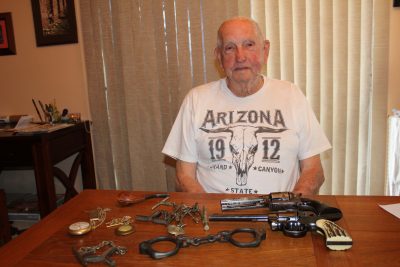
Jack Gorham with his dad’s equipment
SPECIAL THANKS TO JACK GORHAM FOR PROVIDING PHOTOS AND STORIES ABOUT HIS FATHER AND FAMILY.

